KKIA ransomware sneakily encrypts your files
Contents
KKIA ransomware is a newly emerged computer virus that maliciously encrypts files contained in any computer it infects. It belongs to the notorious STOP/DJVU ransomware family and after encrypting files, it will append .kkia extension to each file name. For instance, a file that was formerly known as 1.jpg will automatically become 1.jpg.kkia after an attack. While the attack is still ongoing, ransomware notes known as _readme.txt will equally be dropped in all the folders. Contained in these _readme.txt ransom notes are pieces of information notifying the victim about the development and why they would have to pay ransom in order to receive KKIA decryption tool.
The cybercriminals will emphasize that KKIA ransomware virus was able to encrypt all files contained in the infected computer, including pictures, documents and various data that may be of critical importance to the victim. Also, by virtue of the very strong and unique key used in the process, the victim would have no way out except to pay certain fees as ransom for them to decrypt the files. To that effect, two email addresses (support@sysmail.ch and supportsys@airmail.cc) will also be provided to facilitate further discussion between both parties.
Decryption service prices will also be included in the ransom note as well as conditions attached with the payment. The cybercriminals will inform the victim that paying ASAP would enable them to pay only 50%. In other words, if they could pay within 72 hours of being notified, the ransom fee would be brought down to $490 but failure to meet up within that timeframe would mean paying the full ransom fee of $980.
If the victim decides to contact them through any of the emails they dropped in the ransom note, they will state that payment can only be made with cryptocurrency whereby the victim will buy its equivalence and transfer same to a wallet address that would be provided by them. The apparent reason why only this method of payment is acceptable to them is to cover their tracks and remain untraceable. To assure the victim of their expertise, they may ask the victim to send parts of the encrypted file to them for test decryption, but will also add that such parts must not contain any information they could perceive as important.

Nevertheless, our cybersecurity experts recommend that victims should follow FBI’s guidelines in matters relating to ransom demand/payment, and it clearly warns that ransom should not be paid. There are several reasons why ransom payment is strongly discouraged but the major ones are listed below:
- Paying ransom does not guarantee you will get your encrypted files back to normal.
- When you pay ransom, you’re making ransomware attack profitable for them which would only perpetuate the circle.
- More funds at their disposal will enable them to expand their criminal activities.
Moreover, the virus is known for dropping other Trojans (AZORULT, VIDAR etc.) that could discreetly steal secretly kept information such as banking details, software login credentials, cryptocurrency wallets, passwords etc. from the compromised computer. Such loss of sensitive information to cybercriminals could lead to further problems like blackmails and theft among others.
Victims of this STOP/DJVU ransomware version are advised to remove KKIA ransomware virus from their infected computer as quickly as possible. The most effective way to do so is set up the computer in Safe Mode with Networking booting process before applying any strong and up-to-date antivirus on it. The importance of using only genuine antivirus software can never be overemphasized because it could make or mar the entire process. Therefore, we recommend the use of INTEGO Antivirus because it has been tested and trusted. You should also consider downloading RESTORO which you can use to repair damages on your Windows OS files.
Ransomware Summary
| Name | KKIA Ransomware Virus |
| Type | Ransomware; Crypto-malware; Virtual Extortion Virus |
| Family | STOP/DJVU |
| Encryption type | RSA 2048 + Salsa20 |
| Previous versions | KAAA, BGJS, BGZQ (find full list here) |
| Version | 425th |
| Extension | .kkia |
| Cybercriminal emails | support@sysmail.ch and supportsys@airmail.cc |
| Additional malware dropped | Azorult or Vidar Trojan |
| Damage | The virus encrypts user’s files on infected computer and makes them distinguishable by appending an additional .kkia extension to their names. The ransomware leaves _readme.txt ransom note in every PC folder. This malware variant tends to install VIDAR Stealer to steal sensitive information from the computer. The ransomware deletes Volume Shadow Copies and modifies Windows HOSTS file to restrict computer user’s access to cybersecurity-related websites online. |
| Ransom note | _readme.txt |
| Ransom demand | $490-$980 in Bitcoin |
| Distribution | Victims often download this ransomware along illegal torrent downloads, cracked software, activators, key generators or tools like KMSPico. |
| Known software cracks to contain this malware | Corel Draw, Tenorshare 4ukey, Adobe Photoshop, Cubase, Adobe Illustrator, Internet Download Manager, Tally, League of Legends. |
| Detection names | Ransom:Win32/StopCrypt.PAL!MTB (Microsoft), Trojan.Crypt (A) (Emsisoft), HEUR:Trojan-Ransom.Win32.Stop.gen (Kaspersky), Trojan.GenericKD.47850419 (BitDefender), Trojan.MalPack.GS (Malwarebytes), ML.Attribute.HighConfidence (Symantec) see all detection name variations on VirusTotal |
| Removal | Remove ransomware and related malware from your PC using professional software of your choice. We highly recommend using INTEGO Antivirus. To repair virus damage on Windows OS files, consider scanning with RESTORO. |
REPAIR VIRUS DAMAGE
Scan your system for FREE to detect security, hardware and stability issues. You can use the scan results and try to remove threats manually, or you can choose to get the full version of software to fix detected issues and repair virus damage to Windows OS system files automatically. Includes Avira spyware/malware detection & removal engine.
Ransomware distribution techniques in detail: avoid getting infected
The most typical ransomware proliferation method used by digital criminals behind STOP/DJVU including the likes of KKIA virus is through malicious online torrents whereby they would upload pirated software copies embedded with malware to such platforms. Some of them include the so-called “cracks” and key generators, and when unsuspecting users download them to their PC, they end up infecting them with virus. Over the years, victims of ransomware have complained about such attacks after they downloaded certain pirated software contents from various online torrent libraries as listed below:
- Adobe Photoshop;
- Adobe Illustrator;
- AutoCad;
- Cubase;
- Corel Draw;
- Fifa 20;
- VMware Workstation;
- Tenorshare 4ukey;
- Opera browser;
- League of Legends;
- Internet Download Manager;
- KMSPico (illegal Windows activation tool).
For those that usually go through online torrents platforms looking for software contents to download illegally, it would be in best interest to desist from such activities. Such places are a haven for cybercriminals looking for unsuspecting computer users to prey on. Those pirated software copies embedded with malware are used as a bait to catch their victims unawares. Also remember that such illegal downloads are considered acts of copyright infringement and is punishable by law.
Instead of exposing yourself to all these, we suggest that legitimate and genuine software developers should be encouraged by obtaining their works through the right channels as endorsed by them. Whatever fee they may request for their products is relatively small and can never be compared to the outrageous ransom fee demanded by cybercriminals. Another advantage is that you won’t be at risk of losing your important and sensitive files.
Another ransomware distribution method used by cybercriminals is through malicious email attachments. In this option, they would compose extremely believable messages that would be accompanied with custom-made attachments crafted using platforms like XLS, PDF and DOCX. These platforms are their preferred choice because they allow JavaScript and Macro Functions, both of which can be used in conveying payload from external sources and also releasing them on other computers.
The main challenge is how to differentiate between real emails and those sent by online crooks. This situation arose because they’ve mastered the act of deception. They may decide to impersonate as someone known to you or just any random but popular company brand such as eBay, FedEx, Amazon, UPS etc. and would also name the attachments with enticing captions like Invoice, Order Summary or Tracking Details. Alternatively, they may also leverage email spoofing methods to obfuscate the actual criminal’s email address. Whatever method they may try to use, you should always be on guard when opening emails, if such an email isn’t expected or intelligible with you, then it should be considered a red flag and ought not to be opened.
Finally, STOP/DJVU ransomware victims are advised to shun certain suspicious websites that often advertise about decryption solutions because such hardly exist. At the moment only DiskTuna and Emsisoft have proven capabilities of repairing files affected by STOP/DJVU ransomware virus. You can follow this link for an explanation about them.
More information about the virus
This section deals with the technical aspect of KKIA ransomware and how it affects the computer. Firstly, the malware will set up build.exe or build2.exe as well as winupdate.exe the prompt that displays fake update screen on Windows. Once it is done with that, it will connect to https[:]//api.2ip.ua/geo.json and also save the outcome in geo.json file. This file contains every relevant detail concerning the computer geolocation, such as: time zone, country, city, zip code, longitude and latitude, and others. Examples of the geo.json file are shown in the screenshot below.

The virus also drops information.txt file which contains computer’s hardware specifics, active processes and installed programs’ names.

At this stage, the malware will profile the computer’s geolocation against a list of countries they designated as encryption-protected and they include: Russia, Syria, Armenia, Ukraine, Tajikistan, Kazachstan, Kyrgyzstan, Uzbekistan and Belarus. If it detects that the computer under attack is located in any of the above countries, the ransomware will immediately halt any further action.
However, if on the other hand it reads negative, the ransomware will now fetch online encryption key from their server and would merge it with the victim’s ID and would save them in the bowsakkdestx.txt file and also the ID separately to the PersonalID.txt file. Examples of these files are shown below.

Peradventure it fails to extract any online encryption key from their server; it will resort to the use of hardcoded offline key as an alternative. The major difference both keys is that online key is specific to each victim while offline key is the same for all victims of the same variant. The presence of t1 characters suffixed at the end of the victim’s ID is an indication that offline key was used and it increases the possibility of decrypting .kkia files someday. More information about it is provided below.
The ransomware will at this point commence data encryption by scanning every folder and encrypting each file with Salsa20 algorithm. Afterwards, it will lock the encryption key using RSA-2048 code. Each file will be marked with additional extension. You can see how an affected data folder appears down below.

Here is an image of _readme.txt ransom note that is usually dropped in all the folders.

The malware will blacklist some specific domains by adding them to the Windows HOSTS file and any attempt by the victim to browse such domains will only bring up DNS_PROBE_FINISHED_NXDOMAIN error message. The aim of doing this is to preempt any attempt by the victim to seek help online.
Remove KKIA Ransomware Virus and Restore Your Files
The first thing that should be done by victims whose computers were infected by this virus is to remove the ransomware as quickly as possible. To do this effectively, you should set up the compromised computer in Safe Mode with Networking as stated earlier and also apply RESTORO or any similar one. Also download RESTORO for purposes of repairing damages on Windows system files. Please refer to appropriate section above for more details on this.
Now that you have removed KKIA ransomware, it is time to do the following:
- Let local law enforcement agencies know about the ransomware attack you’ve experienced.
- Restore lost data using any available backup device.
- Change all login credentials that were used on the infected computer.
- Read more about possible data repair/decryption options available for files affected by STOP/DJVU versions.
OUR GEEKS RECOMMEND
Our team recommends removing malware using a professional antivirus software.
REMOVE THREATS WITH ROBUST ANTIVIRUS

Get INTEGO ANTIVIRUS for Windows to remove ransomware, Trojans, adware and other spyware and malware variants and protect your PC and network drives 24/7. This VB100-certified security software uses state-of-art technology to provide protection against ransomware, Zero-Day attacks and advanced threats, Intego Web Shield blocks dangerous websites, phishing attacks, malicious downloads and installation of potentially unwanted programs.
Use INTEGO Antivirus to remove detected threats from your computer.
GeeksAdvice.com editors select recommended products based on their effectiveness. We may earn a commission from affiliate links, at no additional cost to you. Learn more.
KKIA Ransomware Virus Removal Guidelines
Method 1. Enter Safe Mode with Networking
Step 1. Start Windows in Safe Mode with Networking
Before you try to remove KKIA Ransomware Virus virus, you must start your computer in Safe Mode with Networking. Below, we provide the easiest ways to boot PC in the said mode, but you can find additional ones in this in-depth tutorial on our website – How to Start Windows in Safe Mode. Also, if you prefer a video version of the tutorial, check our guide How to Start Windows in Safe Mode on Youtube.
Instructions for Windows XP/Vista/7 users
- First of all, turn off your PC. Then press the Power button to start it again and instantly start pressing F8 button on your keyboard repeatedly in 1-second intervals. This launches the Advanced Boot Options menu.
- Use arrow keys on the keyboard to navigate down to Safe Mode with Networking option and press Enter.

Instructions for Windows 8/8.1/10/11 users
- Open Windows Start menu, then press down the Power button. On your keyboard, press down and hold the Shift key, and then select Restart option.

- This will take you to Windows Troubleshoot screen. Choose Troubleshoot > Advanced Options > Startup Settings > Restart. Tip: If you can't find Startup Settings, click See more recovery options.

- In Startup Settings, press the right key between F1-F9 to enter Safe Mode with Networking. In this case, it is the F5 key.

Step 2. Remove files associated with the virus
Now, you can search for and remove KKIA Ransomware Virus files. It is very hard to identify files and registry keys that belong to the ransomware virus, Besides, malware creators tend to rename and change them repeatedly. Therefore, the easiest way to uninstall such type of a computer virus is to use a reliable security program such as INTEGO Antivirus. For virus damage repair, consider using RESTORO.
Special Offer
Compatibility: Microsoft Windows
See Full Review
RESTORO is a unique PC Repair Tool which comes with an in-built Avira scan engine to detect and remove spyware/malware threats and uses a patented technology to repair virus damage. The software can repair damaged, missing or malfunctioning Windows OS files, corrupted DLLs, and more. The free version offers a scan that detects issues. To fix them, license key for the full software version must be purchased.
Method 2. Use System Restore
In order to use System Restore, you must have a system restore point, created either manually or automatically.
Step 1. Boot Windows in Safe Mode with Command Prompt
Instructions for Windows XP/Vista/7 users
- Shut down your PC. Start it again by pressing the Power button and instantly start pressing F8 button on your keyboard repeatedly in 1-second intervals. You will see Advanced Boot Options menu.
- Using arrow keys on the keyboard, navigate down to Safe Mode with Command Prompt option and press Enter.

Instructions for Windows 8/8.1/10/11 users
- Launch Windows Start menu, then click the Power button. On your keyboard, press down and hold the Shift key, and then choose Restart option with the mouse cursor.

- This will take you to Windows Troubleshoot screen. Choose Troubleshoot > Advanced Options > Startup Settings > Restart. Tip: If you can't find Startup Settings, click See more recovery options.

- In Startup Settings, press the right key between F1-F9 to enter Safe Mode with Command Prompt. In this case, press F6 key.

Step 2. Start System Restore process
- Wait until system loads and command prompt shows up.
- Type cd restore and press Enter, then type rstrui.exe and press Enter. Or you can just type %systemroot%system32restorerstrui.exe in command prompt and hit Enter.

- This launches System Restore window. Click Next and then choose a System Restore point created in the past. Choose one that was created before ransomware infection.

- Click Yes to begin the system restoration process.
After restoring the system, we recommend scanning the system with antivirus or anti-malware software. In most cases, there won't be any malware remains, but it never hurts to double-check. In addition, we highly recommend checking ransomware prevention guidelines provided by our experts in order to protect your PC against similar viruses in the future.
Alternative software recommendations
Malwarebytes Anti-Malware
Removing spyware and malware is one step towards cybersecurity. To protect yourself against ever-evolving threats, we strongly recommend purchasing a Premium version of Malwarebytes Anti-Malware, which provides security based on artificial intelligence and machine learning. Includes ransomware protection. See pricing options and protect yourself now.

System Mechanic Ultimate Defense
If you're looking for an all-in-one system maintenance suite that has 7 core components providing powerful real-time protection, on-demand malware removal, system optimization, data recovery, password manager, online privacy protection and secure driver wiping technology. Therefore, due to its wide-range of capabilities, System Mechanic Ultimate Defense deserves Geek's Advice approval. Get it now for 50% off. You may also be interested in its full review.

Disclaimer. This site includes affiliate links. We may earn a small commission by recommending certain products, at no additional cost for you. We only choose quality software and services to recommend.
Decrypt KKIA files
Fix and open large KKIA files easily:
It is reported that STOP/DJVU ransomware versions encrypt only the beginning 150 KB of each file to ensure that the virus manages to affect all files on the system. In some cases, the malicious program might skip some files at all. That said, we recommend testing this method on several big (>1GB) files first.
- Create a copy of encrypted file to a separate folder using Copy > Paste commands.
- Now, right-click the created copy and choose Rename. Select the KKIA extension and delete it. Press Enter to save changes.
- In the prompt asking whether you want to make the changes as file might become unusable, click OK.
- Try opening the file.
STOP/DJVU decryption tool usage guide
STOP/DJVU ransomware versions are grouped into old and new variants. KKIA Ransomware Virus is considered the new STOP/DJVU variant, just like KAAA, BGJS, BGZQ (find full list here). This means full data decryption is now possible only if you have been affected by offline encryption key. To decrypt your files, you will have to download Emsisoft Decryptor for STOP DJVU, a tool created and maintained by a genius security researcher Michael Gillespie.
Note! Please do not spam the security researcher with questions whether he can recover your files encrypted with online key - it is not possible.
In order to test the tool and see if it can decrypt KKIA files, follow the given tutorial.
- Download the decryption tool from Emsisoft.
- Click the little arrow next to your download and choose Show in Folder.
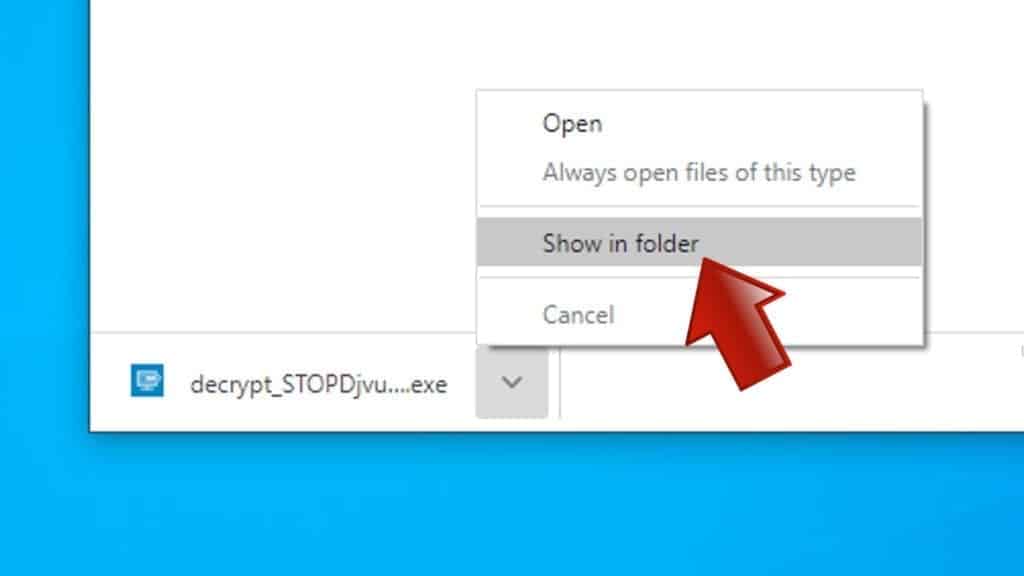
- Now, right-click the file and choose Run as Administrator. If asked, enter administrator's password.
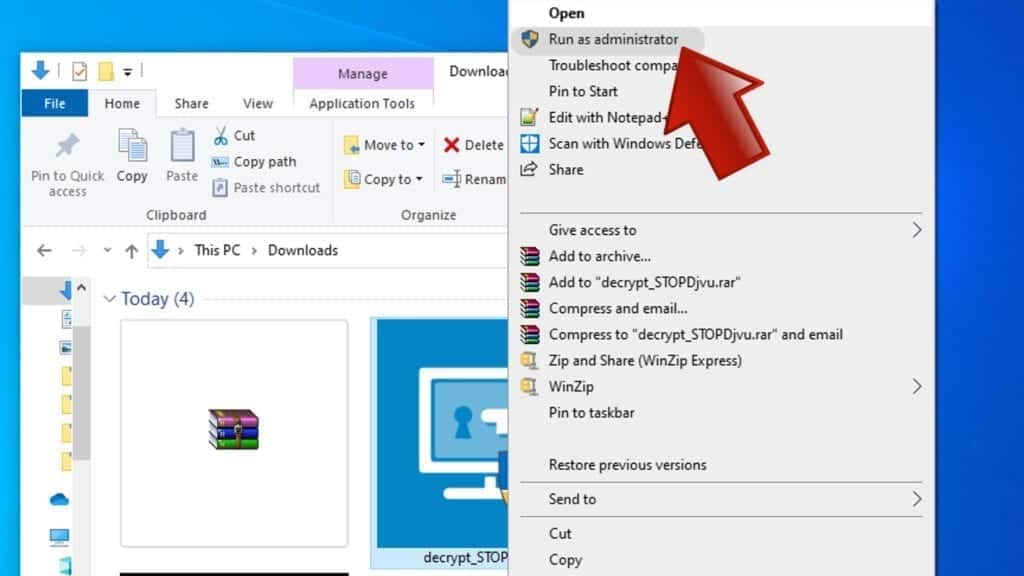
- In UAC window, click Yes.
- Click Yes to agree to software terms in both windows.
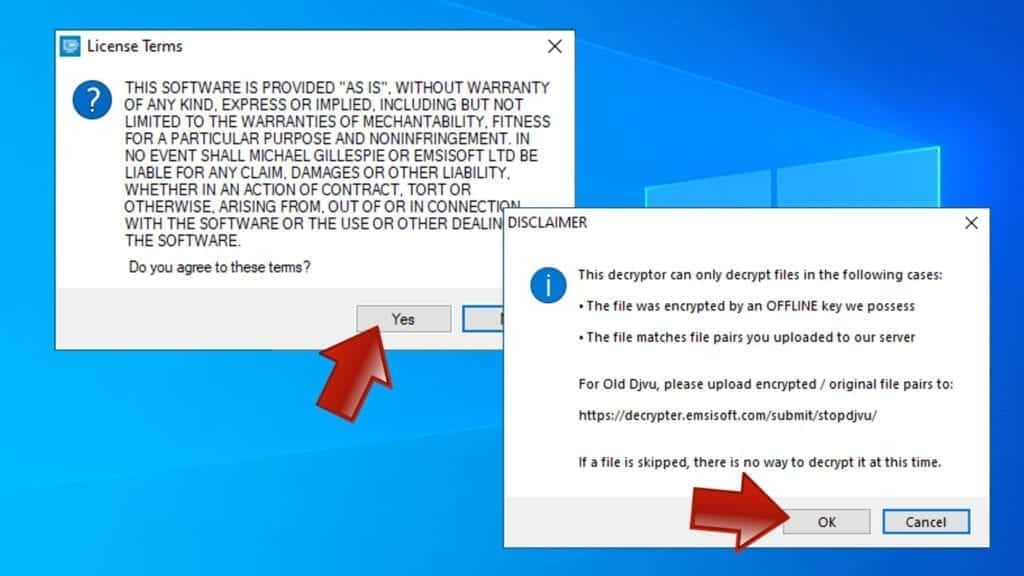
- The tool will automatically include C:// disk as a location to decrypt. The file recovery tool will prepopulate the locations to scan, including connected data storage drives or network drives. Click Add folder if you wish to add additional locations.
In Options tab, you can choose to keep encrypted file copies. We recommend leaving this option selected, especially if you do not know if the decryption tool will work.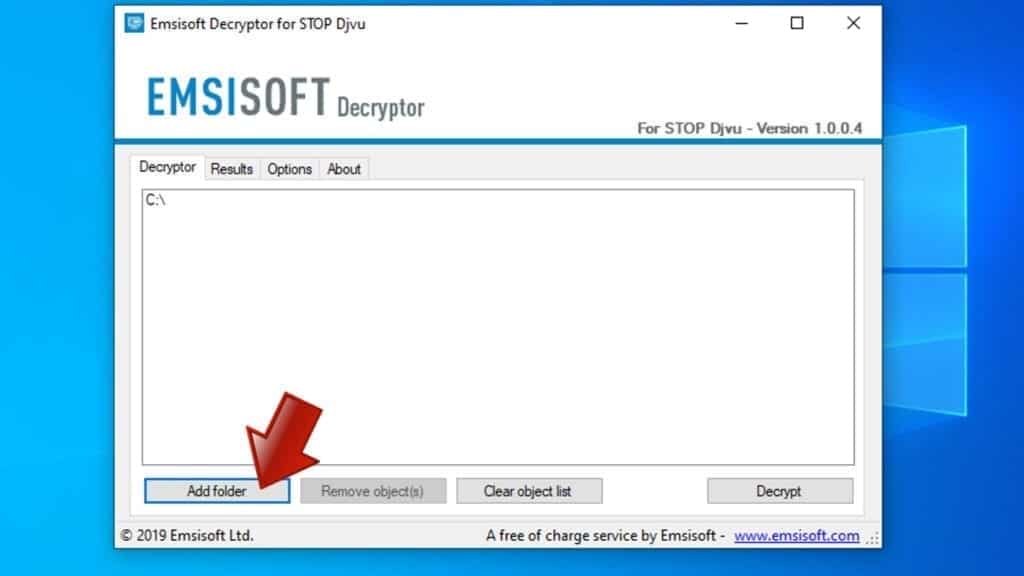
- Click Decrypt to start restoring KKIA files. You will see the progress in the Results tab. Here, you can see messages from the tool, such as whether the decryption procedure is successful, or you need to wait for an update.
You might also be informed that online key was used to encrypt your files. In such case, the decryption tool won't work for you, and the only way to recover your files is to use a data backup.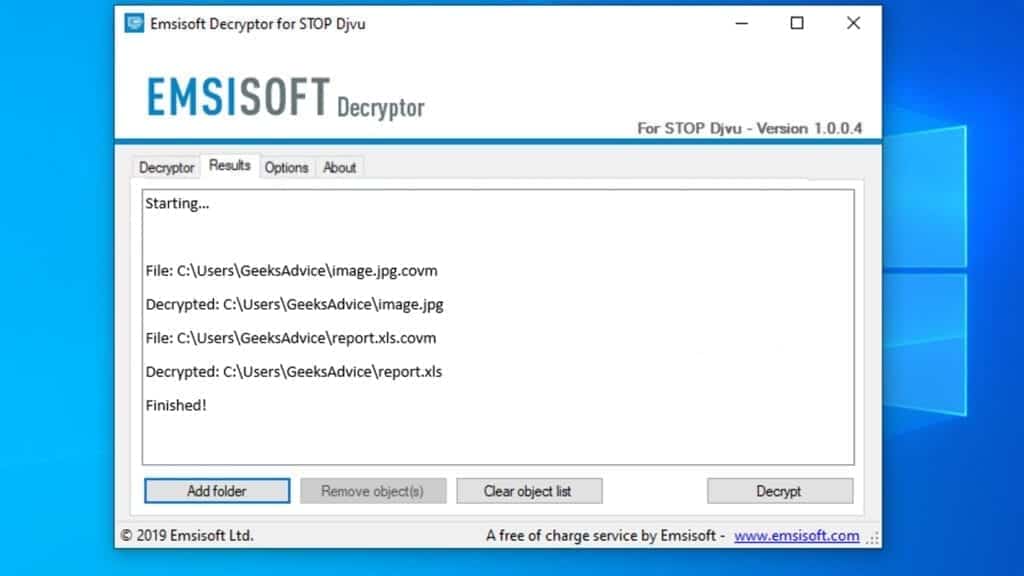
Meanings of decryptor's messages
The KKIA decryption tool might display several different messages after failed attempt to restore your files. You might receive one of the following messages:
Error: Unable to decrypt file with ID: [example ID]
This message typically means that there is no corresponding decryption key in the decryptor's database.
No key for New Variant online ID: [example ID]
Notice: this ID appears to be an online ID, decryption is impossible
This message informs that your files were encrypted with online key, meaning no one else has the same encryption/decryption key pair, therefore data recovery without paying the criminals is impossible.
Result: No key for new variant offline ID: [example ID]
This ID appears to be an offline ID. Decryption may be possible in the future.
If you were informed that an offline key was used, but files could not be restored, it means that the offline decryption key isn't available yet. However, receiving this message is extremely good news, meaning that it might be possible to restore your KKIA extension files in the future. It can take a few months until the decryption key gets found and uploaded to the decryptor. We recommend you to follow updates regarding the decryptable DJVU versions here. We strongly recommend backing up your encrypted data and waiting.
Report Internet crime to legal departments
Victims of KKIA Ransomware Virus should report the Internet crime incident to the official government fraud and scam website according to their country:
- In the United States, go to the On Guard Online website.
- In Australia, go to the SCAMwatch website.
- In Germany, go to the Bundesamt für Sicherheit in der Informationstechnik website.
- In Ireland, go to the An Garda Síochána website.
- In New Zealand, go to the Consumer Affairs Scams website.
- In the United Kingdom, go to the Action Fraud website.
- In Canada, go to the Canadian Anti-Fraud Centre.
- In India, go to Indian National Cybercrime Reporting Portal.
- In France, go to the Agence nationale de la sécurité des systèmes d’information.
If you can't find an authority corresponding to your location on this list, we recommend using any search engine to look up "[your country name] report cyber crime". This should lead you to the right authority website. We also recommend staying away from third-party crime report services that are often paid. It costs nothing to report Internet crime to official authorities.
Another recommendation is to contact your country's or region’s federal police or communications authority.
Frequently Asked Questions
You can only open KKIA files if you have the decryption key, or if you were affected by offline encryption type.
To figure out whether you were affected by offline encryption, please go to C:/SystemID/PersonalID.txt and see if the string inside of it ends in t1. You can also try using Emsisoft Decryptor for STOP/DJVU.
Please follow the guidances provided by the official KKIA decryption tools and believe what they say. If they say it is impossible to decrypt, it really is so. There is no magic tool or human capable of decrypting your files hiding somewhere. Encryption is a technique created to be nearly impossible to decrypt without a special private key (held by the criminals).
We advise scanning with anti-virus, anti-malware, malware removal tools or software like RESTORO to eliminate virus damage on the system. If you do not trust using a single tool, try running one after another. However, we do not recommend keeping several security programs on a computer at once as they can interfere with each other's work.
Beware of fake KKIA decryption tools circulating around the web. Cyber criminals are uploading them to various shady websites, also might be promoting them via suspicious Youtube videos. These programs can infect your computer even more heavily (Trojans, miners, etc.). We suggest being extremely cautious around the web. If there will be an official STOP/DJVU decryption tool available, it will be widely discussed in public media.

Norbert Webb is the head of Geek’s Advice team. He is the chief editor of the website who controls the quality of content published. The man also loves reading cybersecurity news, testing new software and sharing his insights on them. Norbert says that following his passion for information technology was one of the best decisions he has ever made. “I don’t feel like working while I’m doing something I love.” However, the geek has other interests, such as snowboarding and traveling.
Leave a Reply